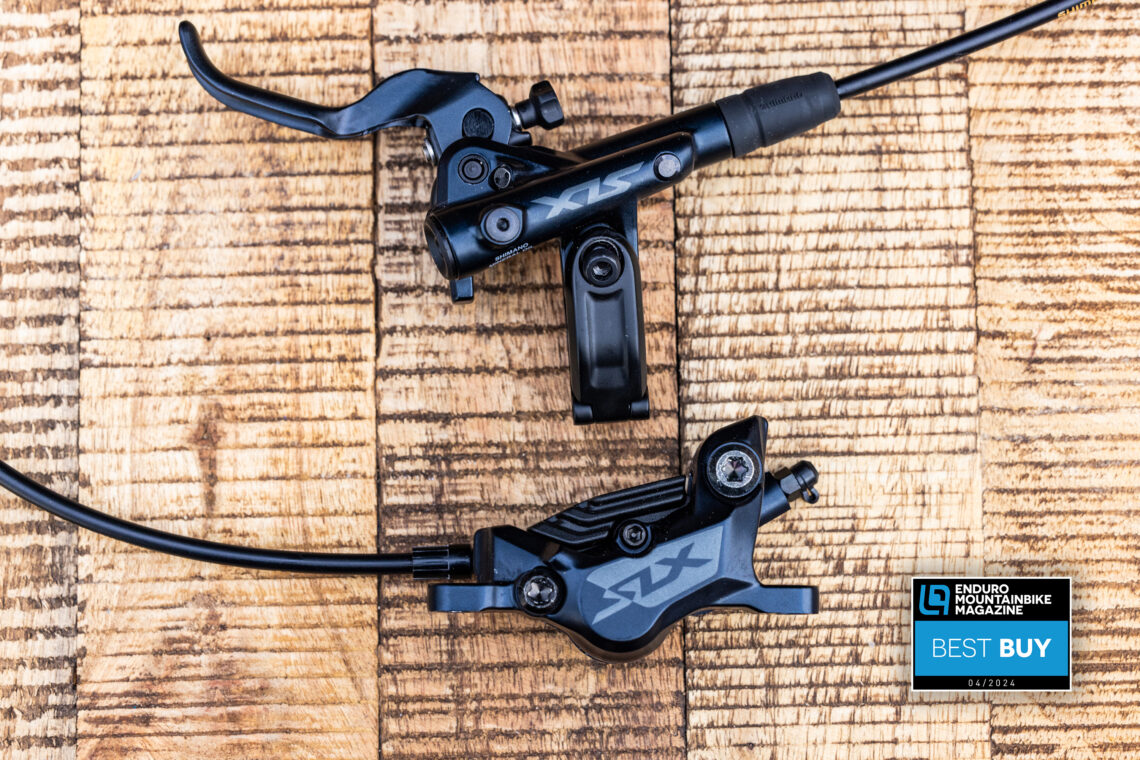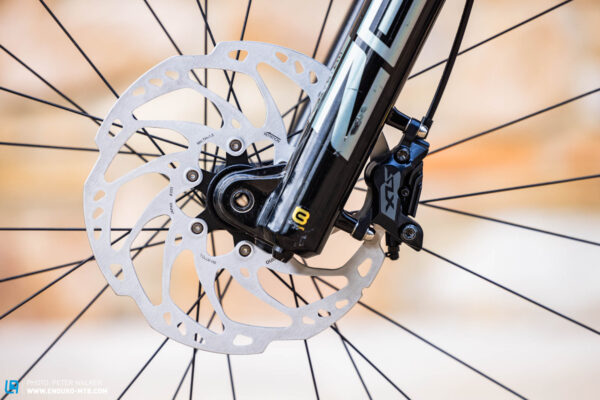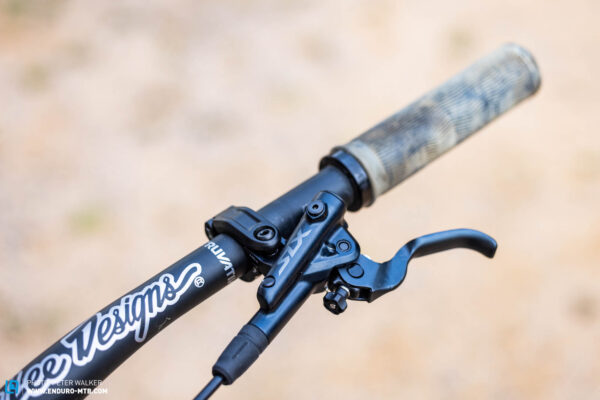The Shimano SLX M7120 is the cheapest brake in this comparison test. Retailing at € 350, it’s also the second cheapest model in the entire test field, and takes on the competition with a discreet look and and Japanese build quality. Is that enough to win the test?
Learn more about this comparison test: The best MTB disc brakes – 14 MTB brakes in comparison

Shimano’s portfolio is truly massive and includes brakes, drivetrains and whole groupsets, which can be a little confusing – we’ll shed some light on this right now. As far as product names go, the Shimano range has remained pretty much unchanged over the past few years. Alongside the CUES and DEORE entry-level groupsets, Shimano offer three “X” ranges: SLX, XT and XTR. We tested the four piston variants of all of the “X” models, but there are two piston versions available too. First we’re taking a closer look at the Shimano SLX, and later on we’ll get to the XT and XTR models.
The SLX are Shimano’s bread & butter brakes and, at 600 g without rotors, fall right in the middle of the test field of our big brake comparison test in terms of weight. At first glance, they’re almost identical to the XT and XTR, except for the finish. Upon closer inspection, however, the SLX aren’t quite as high-quality as their higher-end counterparts. The lever blades lack the grip-enhancing dimples of the top models, and there is no free stroke adjustment – not that we think that is necessarily a bad thing, as on the XT and XTR variants, it seems to be more of a placebo than a useful feature, and many multitools lack the necessary Phillips bit to adjust it. Lever reach is adjustable without tools.


The clamping system of the SLX brakes is well thought out, using Shimano’s proprietary I-SPEC system to ensure good compatibility . To release the handlebar clamp, you just have to loosen one bolt, then press the locking pin with something pointy. Once the clamp is open, you can remove the whole lever – the bolt itself is secured with a rubber O-ring, meaning that it can’t fall out accidentally!
Bleeding Shimano brakes is pretty easy, with a “one way” bleed system only requiring you to thread a funnel into the lever’s bleed port: position the lever horizontally, fill the funnel, thread it into the bleed port and pull the brake lever a few times to release excess air from the hose. Anyone can do it! And if something goes wrong, the mineral oil isn’t as bad as DOT fluid, which corrodes the paint and is harmful to the skin.

Shimano SLX on test
The Shimano SLX brakes perform a solid performance on the trail and deliver a similar amount of braking power as the other Shimano brakes in this test. Like its bigger siblings, the SLX is pretty snappy, featuring Shimano’s typical “on-off” brake feel, which is a lot more direct than other brakes like the Hope, Trickstuff and Hayes. The SLX delivers its power almost instantly, but is nevertheless easy to modulate with a bit of fingertip feeling. Our BrakeAce data from the trail test suggests that the SLX is actually more powerful than its top-tier counterpart, the Shimano XTR, showing fewer and shorter braking events on the same test track, with a very balanced fore-aft distribution of 40 to 60. However, in our lab tests, the Shimano XTR gains three positions over the SLX. Nevertheless, the Shimano SLX does everything right and doesn’t cost a fortune, ensuring powerful deceleration even in extreme situations. Compared to the more expensive Shimano models, you only have to make a small compromise in terms of weight, which is why the SLX secured the coveted “Best Buy” badge in our big 2024 brake comparison. For € 350, the Shimano SLX leaves nothing to be desired, and impresses with workmanship, brake feel, ergonomics and, of course, trail performance. If you want even more final braking torque, you can upgrade the SLX with Sinter Green pads, which put the braking power on a par with the considerably more expensive Trickstuff MAXIMA in our lab testing.
Our conclusions about the Shimano SLX
The Shimano SLX strikes the best price-performance ratio in the entire test field, impressing with powerful deceleration and excellent modulation. While the snappy on/off actuation might take a little getting used to, the overall brake feel and ergonomics are superb. Bleeding is pretty easy too, making the SLX an excellent choice for those riders who don’t like time consuming maintenance routines – our Best Buy recommendation!
Tops
- Excellent one-piece bar clamp
- Easy to bleed
- Plenty of braking power
Flops
- Snappy on/off brake feel is a matter of taste
More info on shimano.com
Find the overview of this comparison test here: The best MTB disc brakes – 14 MTB brakes in comparison
All brakes in test:
Formula Cura 4 | Hayes Dominion T4 | Hope Tech 4 V4 | MAGURA MT5 Pro | MAGURA MT7 | Shimano SLX | Shimano XT | Shimano XTR | SRAM CODE Bronze Stealth | SRAM CODE Ultimate Stealth | SRAM MAVEN Ultimate | Trickstuff MAXIMA | TRP DH-R EVO | TRP Trail EVO |
Did you enjoy this article? If so, we would be stoked if you decide to support us with a monthly contribution. By becoming a supporter of ENDURO, you will help secure a sustainable future for high-quality mountain bike journalism. Click here to learn more.
Words: Julian Schwede Photos: Peter Walker









